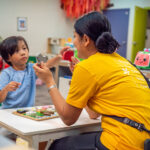Autism and Siblings: Tips to Help Your Neurodivergent and Neurotypical Kids Get Along

FEATURED POSTS
by Katherine Johnson, M.S., BCBA
Senior Director of Partnerships, LEARN Behavioral
All sibling relationships have their ups and downs. Siblings are our first friends, our childhood tormentors, and our longest-lasting connection. With a shared childhood, siblings can often understand each other better than anyone—including how to push each other’s buttons!
These hallmark features of sibling relationships remain true when siblings have different neurological profiles—for instance, when one is autistic and the other not. But there can be additional complexities that make fostering a healthy sibling relationship a bit more work. Here are some tips for nurturing a loving, supportive relationship between your children, when one is autistic, and the other is not.
Use attention-prevention.
Ease the inevitable sibling jealousies by carving out one-on-one time for each child. Neurotypical children may feel unseen as troupes of family members and specialists focus on their autistic sibling. Special “dates” in which they’re the center of attention can help. But you’ll want to carve out intentional time with your autistic child, too—time not spent shuttling to therapies, teaching, or managing behavior but simply engaging and enjoying. If possible, set aside time once a week, but don’t abandon the idea if that’s too ambitious. Just make it monthly or even quarterly.
Be open about their differences.
Staying away from the subject of differences can inadvertently send the message that it is taboo or shameful. Instead, take a step toward a deeper mutual understanding by sharing age-appropriate information with your children about how they think differently. Perspective-taking can be difficult for all children, particularly those who are very young and those with autism. Siblings can offer a rich mine of learning opportunities to build skills in asking for and listening to another’s point of view. Talk about emotions openly and often to teach your kids the range of reactions individuals can have to the same event. Also build a history of open communication, in which your children can come to you with their questions and worries.
Listen, listen, listen.
Let’s be honest—even adults can have difficulty connecting with other people whose brains work in different ways than theirs do. Children need a hefty amount of patience and understanding to learn how to love, care for, and enjoy someone who has a different experience of the world. As negative emotions like jealousy and resentment come up, don’t try to talk them out of them. Listen closely, and validate their feelings before you try to solve anything. Your autistic child may communicate their hurts and disappointments in their own unique way, so “listening” may look different across children. Whatever the case, as you learn to recognize the ways your autistic child communicates, pass on this information to their siblings, to build more understanding among your kids.
Share positive experiences.
One key to establishing a strong relationship is to share positive experiences. This can be tricky if you have kids with vastly different interests, sensory preferences, or abilities. Don’t get stuck in old-fashioned thinking that family togetherness only means board games or sports. Instead, find new ways for siblings to play together. One way to expand everyone’s palate for fun is to have regular family time in which each person takes turns determining the activity. In its simplest form, this shows your children how much you value your time together and respect each family member’s interests, even when you don’t share them. When your kids are ready for it, you can use this as a perspective-taking lesson about considering what others will enjoy.
Assist with conflicts.
When you’re trying to foster a healthy sibling relationship, advice from others is often to “let them work it out on their own.” However, if your kids have different neurological profiles, you may need to help your children build skills to problem-solve their conflicts first. You can prevent physical tussles and diffuse situations before they escalate by teaching them to separate from one another to calm down. To prepare, have them practice going to separate “calm-down spots” during conflict-free times. While this method will help in the short-term, to support conflict resolution long-term, seek to learn each child’s methods of communicating, and help them grow those skills so they can use them to express their needs—and better understand each other.
Seek out similarities.
Although differences among our children may be huge, look for commonalities, and mention them often. Do both of your kids like ice cream or have the same kissable cheeks? Emphasize the similarities, particularly when they involve a shared goal, such as not wanting to go to bed or clean their room. After all, siblings are rarely closer than those shared moments of ganging up on their parents! Even a tense moment in the family can be an opportunity to point out that they’re on the same team.
Parenting multiple children is a stressful endeavor, and when siblings are different, it can feel easier to just let them do things separately. But siblings will be in each other’s lives for longer than most other friends and family, so this is a relationship worth investing time in right from the beginning. A healthy sibling relationship can be a lifelong source of comfort and support—and this is something we want for all of our children.
Looking for the latest on bringing up kids with ASD? Listen to our “10 Top-Performing Podcast Episodes About Autism.”





